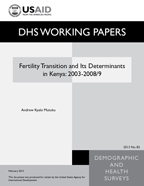
Abstract:
Kenya began to experience rapid fertility
decline in the late 1980s. However, this
decline in fertility stalled in the late
1990s. This study examined factors
influencing transition to third and fourth
births in Kenya for the period between 2003
and 2008/9, in order to provide a better
understanding of the current fertility
transition in Kenya with respect to birth
spacing. Data was obtained from the Kenya
Demographic and Health Surveys (KDHS) of 2003
and 2008/9. Logistic regression model was the
main method of data analysis. The dependent
variable was whether or not a woman had made
a transition from second to third birth and
from third to fourth birth in the five years
preceding each survey. The main independent
variables were: education level, place of
residence (urban-rural), region of the
country, wealth index, marital status,
religion, ever-use of contraception, child
mortality, and mother’s age at the start of
the birth interval.
The results showed that for the five-year
period before KDHS 2008/9 the odds of
transition to a third birth were lower for
women with some education compared with women
with no education. Odds were lower for women
in Central, Eastern, and North Eastern
provinces compared with women in Western
province, but higher for women of the
Protestant religion compared with Catholic
women. The odds of transition to a third
birth were lower for women from middle,
richer, and richest households compared with
women from poorest households, and
lower for women who had ever used a modern
method of contraception compared with women
who had never used contraception.
For the five year-period before KDHS 2008/9,
the odds of transition from third to a fourth
birth were significantly influenced by
education level, wealth index, age at the
start of the interval, ever-use of
contraception, and desire
for an additional child. The results for the
five
year-period before KDHS 2003 showed that
transition
to fourth birth was significantly associated
with region, wealth index, age at the start
of the interval, ever-use of contraception,
and desire for another child.
This paper has two main policy implications.
First, there is a need to improve family
planning services across the country, which
would address the issues of unwanted
fertility and unmet need for family planning
and hence lead to a decline in fertility.
Second, there is also a need to improve the
socioeconomic conditions in the country.
Higher levels of wealth and education are
strongly associated with lower fertility.
 Fertility Transition and Its Determinants in Kenya: 2003-2008/9 (PDF, 521K)
Fertility Transition and Its Determinants in Kenya: 2003-2008/9 (PDF, 521K)
